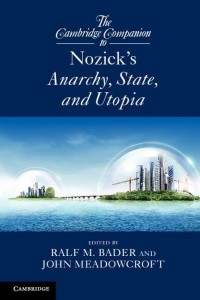Libertarianism, Book/Article Reviews
Reflections on Robert Nozick’s Anarchy, State, and Utopia
 Robert Nozick’s Anarchy, State, and Utopia was published almost forty years ago – the first and still most widely known book in academic philosophy to take libertarian thought seriously. How have its arguments and ideas held up? And what does that tell us about the state of libertarian philosophy?
Robert Nozick’s Anarchy, State, and Utopia was published almost forty years ago – the first and still most widely known book in academic philosophy to take libertarian thought seriously. How have its arguments and ideas held up? And what does that tell us about the state of libertarian philosophy?
The Cambridge Companion to Nozick’s Anarchy, State, and Utopia addresses these questions and more with eleven original essays on all aspects of Nozick’s book: his argument against the individualist anarchist, his side-constraint view of moral rights, his libertarian theory of justice, his critique of Rawls, and his argument that the minimal state constitutes a “utopia of utopias.” The essays are written by an all-star crew, including David Schmidtz, Gerald Gaus, Peter Vallentyne, Eric Mack, Barbara Fried, Chandran Kukathas, and more. And, for an academic book, it’s pretty reasonably priced on Amazon at $29.99.
Notre Dame Philosophical Reviews was kind enough to publish my (unusually lengthy) review of the book yesterday. Here’s an bit from the introduction:
Robert Nozick’s Anarchy, State, and Utopia is widely regarded as one of the most influential books of political philosophy of the 20th century. It is certainly the most influential book of libertarian political philosophy, at least within the academy. And yet, for all that, Nozick’s masterpiece has played a rather curiously limited role in academic political philosophy since its publication almost 40 years ago. It has, for instance, produced almost no Nozickians. It hasn’t even really produced very many people who consider themselves to be working in a broadly Nozickian tradition. The one notable exception to this generalization merely heaps irony upon neglect: left-libertarians like Hillel Steiner and Peter Vallentyne follow closely in the neo-Lockean tradition revitalized by Nozick and frequently refer to his work, but all in the service of a politics that is largely opposed to the kind of free market society championed by Nozick. When one compares its reputation with its actual effects, one might just conclude that Anarchy, State, and Utopia is the most uninfluential influential book ever written.
And from the conclusion:
There is, of course, more to ASU, and more to this companion, than the five ideas on which I have focused in this review. But the discussion here is suggestive of some general conclusions about the significance of Nozick’s work. One important conclusion is this: almost all of the central arguments that Nozick sets out in ASU in defense of the minimal state are generally regarded as (at best) less than fully successful, even by philosophers who are sympathetic to his libertarian position.
But just as ASU was not the first word on libertarianism (Nozick drew much of his inspiration from conversations with Murray Rothbard), it is also not (and was not intended to be) the last word (ASU, xii). It is not even the last word on Nozickian libertarianism. Despite his seeming rejection of libertarianism in The Examined Life, Nozick stressed in his last published interview that he never stopped identifying himself as a libertarian. And in his last book, Invariances, he defended a libertarian principle of voluntary cooperation as “the core principle of ethics.” True, he does not defend that principle on grounds of self-ownership (though perhaps he never did in ASU, either — the word appears only once in its 353 pages and seems largely to be a product of G.A. Cohen’s influential criticism of Nozick). Instead Nozick, and contemporary libertarians too, seem more concerned with considerations of mutual benefit and peaceful cooperation.
Libertarian thought has thus largely moved on from ASU, in terms of both the character of its arguments and the contours of its conclusions. But to admit this is hardly to denigrate the achievement, beauty, and fun of the book. As the editors of the Cambridge Companion write, and as the essays in their volume attest, ASU is a rich source of “insightful suggestions, ideas, and arguments, as well as a range of powerful criticisms of alternative views” (11). It was the fountainhead of a research program that has been, and continues to be, enormously fruitful.
Lots more in between. Feel free to go read the whole thing yourself!

